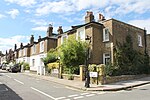Lyndhurst Hall, Kentish Town
CongregationalismDemolished buildings and structures in LondonFormer buildings and structures in the London Borough of CamdenHistory of the London Borough of CamdenKentish Town

Lyndhurst Hall was an Victorian mission hall built by Hampstead's Lyndhurst Road Congregational Church. Located in Warden Road, Kentish Town, it was later sold on and used as a community hall, before being demolished in 2006 to make way for flats.
Excerpt from the Wikipedia article Lyndhurst Hall, Kentish Town (License: CC BY-SA 3.0, Authors, Images).Lyndhurst Hall, Kentish Town
Warden Road, London Chalk Farm (London Borough of Camden)
Geographical coordinates (GPS) Address Nearby Places Show on map
Geographical coordinates (GPS)
| Latitude | Longitude |
|---|---|
| N 51.5484 ° | E -0.149 ° |
Address
Hawkridge House
Warden Road
NW5 4SA London, Chalk Farm (London Borough of Camden)
England, United Kingdom
Open on Google Maps









